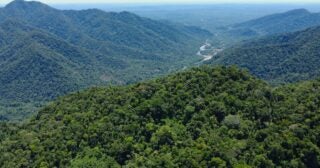- Resources
- What buyers need to know now about new changes in the carbon market for critical forest protections
Resources
What buyers need to know now about new changes in the carbon market for critical forest protections
Published: November 21, 2024 by Jordan Faires
A new consensus on forests from the world’s leading carbon market governing body marks a significant turning point for voluntary carbon market (VCM) buyers. Tropical deforestation is a leading driver of global climate change and a source of climate risk in many corporate value chains. And while private sector efforts have mobilized $35 billion for nature-based solutions to-date, new and improved approaches can play a significant role in helping to close the $700 billion global nature-climate finance gap.
REDD+ projects and programs in particular can be valuable for steering private sector finance toward protecting these critical ecosystems, driving positive outcomes for the climate, biodiversity, and sustainable development. The recent approval of three REDD+ methodologies by the Integrity Council for the Voluntary Carbon Market (ICVCM) stands to improve confidence in these solutions and received endorsements from the We Mean Business Coalition, Conservation International, Emergent, and more.
ICVCM’s decision to approve these methodologies[1] reinforces that tropical forest carbon credits are a credible, science-based option for businesses to support one of our most urgent global climate priorities: the preservation and protection of forest ecosystems.
Why Should Corporate Buyers Care About the ICVCM?
The ICVCM’s Core Carbon Principles (CCP) label is emerging as a global marker of carbon credit quality. For resource-constrained sustainability teams, the CCP label can serve as a clear signpost for integrity, helping to focus procurement and diligence efforts toward credit types that have already undergone vetting by the ICVCM.
Buyers are also increasingly expected to align their carbon credit portfolios with CCP-labeled credits to make high-integrity claims, as with the Voluntary Carbon Market Integrity Initiative (VCMI)’s Claims Code of Practice.
The ICVCM’s approval of REDD+ methodologies now gives companies an additional layer of certainty that these tropical forest credits represent genuine environmental impacts.
What Does This Decision on REDD+ Mean for Buyers?
There’s no sugarcoating it: REDD+ has struggled in recent years as buyers grappled with concerns around potential over-crediting from legacy projects and methodologies. This negative publicity has made it challenging for businesses to make the case to stakeholders that tropical forests can play a reliable role in their carbon credit or beyond value chain mitigation strategy.
Yet these high-profile challenges have overshadowed genuine advances in high-integrity REDD+ methodologies (l) and major steps towards jurisdictional REDD+ success (like the Brazilian state of Para’s new $180m LEAF Coalition deal). There is growing consensus from governments and civil society around the importance of private investment in tropical forest conservation – and the need to urgently shift toward nested and jurisdictional-scale crediting. And while recent scientific research from EDF and partners in Nature Climate Change confirms that tropical forest interventions have strong scientific certainty in their underlying quantification of emissions reductions, ICVCM’s approval now gives additional confidence in their methodologies and program implementation.
What Should Buyers Do Now?
ICVCM’s decision unlocks the potential for substantial investment in tropical forests, and buyers can take steps now to position their carbon credit strategies for maximum impact. CCP-labeled REDD+ credits may start to become available in coming months – with substantial supply poised to follow.
Buyers should:
- Align with recommendations from the Tropical Forest Credit Integrity (TFCI) Guide and increase purchasing of high-integrity REDD+ and JREDD+ credits. These consensus recommendations developed by Environmental Defense Fund and global nonprofit organizations, Indigenous Peoples and Local Communities (IPLC), and research partners outline how a company can use their carbon credit purchasing to drive impact, quality and scale in the market. In short, the Guide encourages companies to shift their purchases toward high-quality nested and jurisdictional-scale projects and programs, and companies should move to align their nature credit portfolios with these recommendations.
- Focus particular attention on social integrity and community inclusion while conducting credit due diligence. While CCP labels are a strong indication of credit quality, they are the floor – not the ceiling – for integrity. As companies are completing additional due diligence on both the environmental and social integrity of the credits they’re buying, they should pay particular attention to the full and effective inclusion of Indigenous Peoples and local communities. This includes revenue and benefits sharing deals that are fair and equitable, and monitoring to ensure that these agreements are followed. The sample due diligence questions in the appendix of the TFCI Guide can help as you think through an effective diligence process.
- Anticipate – and support – higher prices for higher-integrity REDD+ credits. At COP 29, national governments under the Forests & Climate Leaders’ Partnership agreed: pricing for credits should accurately reflect benefits of forest protection and the costs of high-integrity program development. Meanwhile, research conducted by EDF and BCG shows that businesses are willing to pay for quality credits (like those from JREDD+ programs). ICVCM is raising that bar for quality, and prices will follow to ensure that jurisdictions and projects can effectively deliver on full community engagement, social inclusion, and environmental benefits – benefiting buyers and communities, and reducing risk, in the long run.
- Consider joining the LEAF Coalition. Backed by four donor governments, 25 major companies, and a range of NGO partners, the LEAF Coalition gives businesses an opportunity to support and transact jurisdictional REDD+ credits under the now CCP-labeled ART TREES V2.0 methodology.
- Watch for further developments for REDD+. ICVCM hasn’t fully finished its work on REDD+, with potential approval of two further ART TREES crediting levels for removals and High Forest, Low Deforestation (HFLD) approaches in coming months. In particular, HFLD credits present the opportunity to drive critically-needed finance to Indigenous Peoples and local communities – and ART TREES HFLD credits are currently on the market.
Seizing the Opportunity
The ICVCM’s endorsement of these high-integrity REDD+ methodologies marks a significant moment for companies looking to make impactful investments in nature-based solutions. With next year’s COP 30 in the Brazilian Amazon coming into view, and CCP-labeled REDD+ credits hitting the market soon, now is the time for companies to leverage this momentum, aligning carbon strategies with high-integrity credits that support the urgent fight against deforestation and climate change.
—
[1] REDD+ methodologies receiving ICVCM CCP approval include the Verified Carbon Standard’s (VCS) Jurisdictional and Nested REDD+ (JNR) Framework v4.1, VCS VM0048 Reducing Emissions from Deforestation and Forest Degradation v1.0, and the REDD+ Environmental Excellence Standard (TREES) v2.0 by ART



